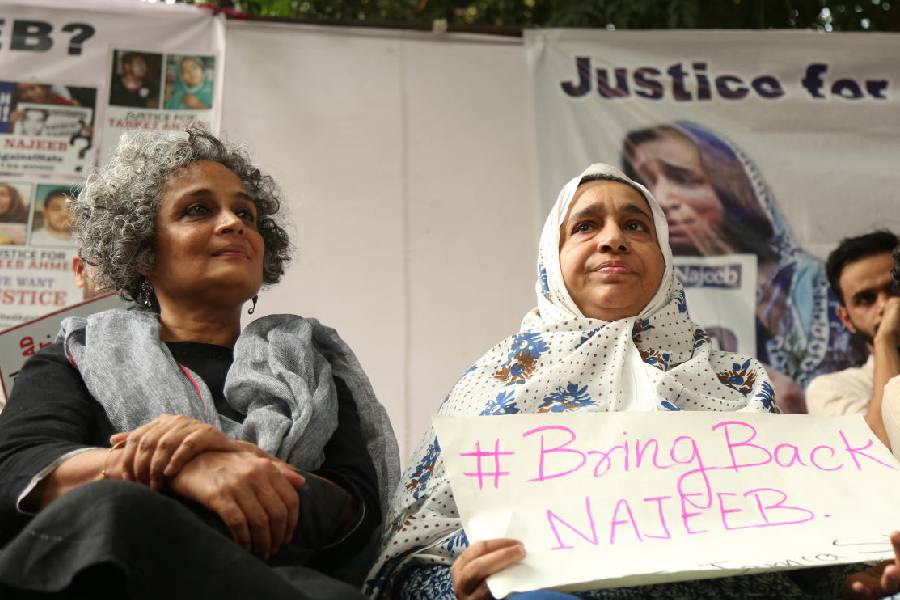|
|
The folded earth By Anuradha Roy, Hachette, Rs 495
Anuradha Roy’s second book has a beautiful cover. It reproduces the elusive colours of the mountains — layers of purple, indigo, turquoise and jade green shifting and merging into one another — creating the folded earth of the title. In between the painted folds, there is a dull yet luminescent patch showing embedded shells, which are often found in the Himalayas, carrying memories of another time when the mountains were the sea. The book, too, is about memories, which keep resurfacing in hag-ridden dreams, in objects tucked away in mildewed corners, or in familiar scents. While it is not unusual for a book to have memories as its theme — indeed, by this time, it is quite hackneyed and often associated with mush — Roy manages to make interesting use of it. Grieving for her dead husband, the protagonist, Maya, cries and faints like a Victorian heroine, but also enacts a wicked revenge at the end that saves the book from being a homage to a self-styled tragedy queen.
Roy creates a quaint world of old, temperamental, rum-drinking landlords, retired generals with lazy dogs, convent schools with ever-complaining nuns, and blustering politicians. The story, being set in Ranikhet, is touched with mountain sights and scents — the ghost of Jim Corbett lurks along with leopards, bells tinkle in the temple of Jhoola Devi, village crones cluck and gossip, while the local bakery “bake[s] Memories”. Twenty-five-year-old Maya takes refuge in Ranikhet at the very start of the novel, when she loses her husband, Michael, in a trekking accident. To match Maya’s subsequent grey mood, Roy gives her a crumbling old mansion called the Light House, with sepia photographs on the mantelpiece dating back to the time when its owner, Diwan Sahib, had been finance minister to the Nawab of Surajgarh, with silverfish scuttling out of dark cupboards, creaking wooden floors and “confused moths that banged into lights”.
Acting out the myth that grieving young hearts find good resting places in mountain convents, Maya starts teaching in a school called St Hilda’s. Diwan Sahib takes her under his ageing wings and rents out the cottage adjoining his house to her. And since life must go on even after death, a Rochester-like nephew of Diwan Sahib, Veer, soon appears on the scene to make Maya fall in love again. Maya’s encounters with Veer make for moments of unintended hilarity. “I breathed on the glass and wrote the stranger’s name in the immediate mist. Veer.” Much later, when Maya would be able to give herself to this mysterious stranger at last, he would point to his mismatched pair of socks (one blue and the other dark green) as proof of what his love for her does to him. Predictably, on that night, the wind howls and the rain falls in torrents, calming the forest fire that has raged for days. After this incident, one can no longer doubt that good-natured celebration of forbidden love is one of the themes of this novel in which the letters of Edwina Mountbatten and Nehru act as the MacGuffin, popping up every now and then, driving the plot on.
If the characters and incidents in the novel are anything to go by, Roy seems to believe in the power of predictability. With the tentative exceptions of Maya, and Diwan Sahib, who is deliciously eccentric, all the characters are fixed in their roles. While in the tradition of Dickens, this induces humour in the best of times, in the worst, it induces irritation. Mr Chauhan, the town administrator, has a penchant for putting up signs with such educative legends as, “Don’t Drive Rash, You Will Crash.” As a man of authority, he is obviously corrupt, greedy and ineffectual, qualities summed up in his appearance: “He had a small, officious-looking moustache, and though he was otherwise skinny, a paunch the size of a watermelon pushed out of his navy-blue pullover.” Whenever this man is encountered in the novel, there are the ubiquitous slogans behind him, as if Roy cannot rest until she has driven home the point she wants to make about him. Similarly, the old General, who has a white moustache curled at the tips and wears a Kumaon Regiment cap, is always seen either walking his dogs or declaiming on the usefulness of the army.
These character types spend their brief times on stage and then are heard no more. Even the sweet village-girl, Charu, who like a modern-day Pastorella tends her cows with loving care until she falls in love with an angelic Nepali cook and runs away, fizzles out suddenly. She goes to Delhi in search of her lover, and there her story ends. We are later told in passing that she has been united with her beloved. It is disappointing that the girl with whom the novel opens is lost midway. But one reason behind these abrupt closures might be the limitations of using Maya as the first-person narrator. In describing Charu’s journey through the mountains to Delhi, the novel switches to the third person, since Maya cannot possibly follow the eloping Charu. As soon as Charu is taken care of, we are returned to Maya’s consciousness again. This creates an abrupt jolt, and one is left wondering about Charu’s fate.
The problem with Maya as a narrator is that happy in her grief, she drifts through the novel, engaging in people’s lives only as much as her personal preoccupations allow her. There is a passive quality to Maya — she is best when she just watches things happening around her. Whenever she has to act, especially romantically — as with Veer — she appears ridiculous. Moreover, she cannot seem to make up her mind on certain things. For instance, Miss Wilson, St Hilda’s principal, often becomes “Mrs Wilson” after having been “Miss Wilson” in the previous sentence. In another place, Maya watches Charu trying to teach herself the alphabet. Charu applies “a piece of chalk to a slate”, later ‘retraces’ “the letters in the dust”, but fails. And then, surprisingly, she is seen “tearing the page up in her fury”. Even if these are editing errors, one can always say that Maya is a dreamer, and has no time for attending to mundane details.
For all its mawkishness, the book is enjoyable. This is chiefly because of Roy’s free-flowing, lyrical language, which is touched and yet can remain untouched by politics, clichés, even death. Finally, the novel is also about finding a home — in the hills — “where life begins and ends”. Maya had discovered after Michael’s death that “his need for the mountains was as powerful as his need for me”. So she migrates to the hills, in whose folds Michael had found his grave, and begins to love the wild place as only a stranger can. The mountains reciprocate by giving her a home, which she had lost first through her marriage against her father’s wishes, and then through Michael’s death. Her final revenge on Veer entails depriving him of his home for having been complicit in Michael’s accident. She loses her lover but gains a refuge and the letters of Edwina and Nehru. So the narrator, and her author, get back to where it all began — to the letter, the word, the word called home.











